Comprehensive Research on CFRP Strengthening of Steel Structures
VerifiedAdded on 2023/01/18
|9
|2137
|37
Report
AI Summary
This research paper explores the application of Carbon Fiber Reinforced Polymer (CFRP) for strengthening steel structures, focusing on circular hollow sections (CHS) and other structural elements. The paper reviews existing literature, including experimental and analytical studies on the bond between steel and CFRP, the strengthening of channel columns, and the design of circular and square hollow sections with CFRP. It also examines the benefits of CFRP, such as increased stiffness, load-carrying capacity, and durability. The research highlights the importance of understanding the bond mechanism and effective bond length for optimal performance. The paper discusses various design equations and methods, comparing them with experimental results and suggesting design rules for CFRP-reinforced steel sections. It also identifies research gaps and areas for future investigation, emphasizing the need for further exploration of CFRP's potential in structural strengthening and repair. The paper provides a comprehensive overview of CFRP strengthening techniques, offering insights into design considerations and performance enhancements.
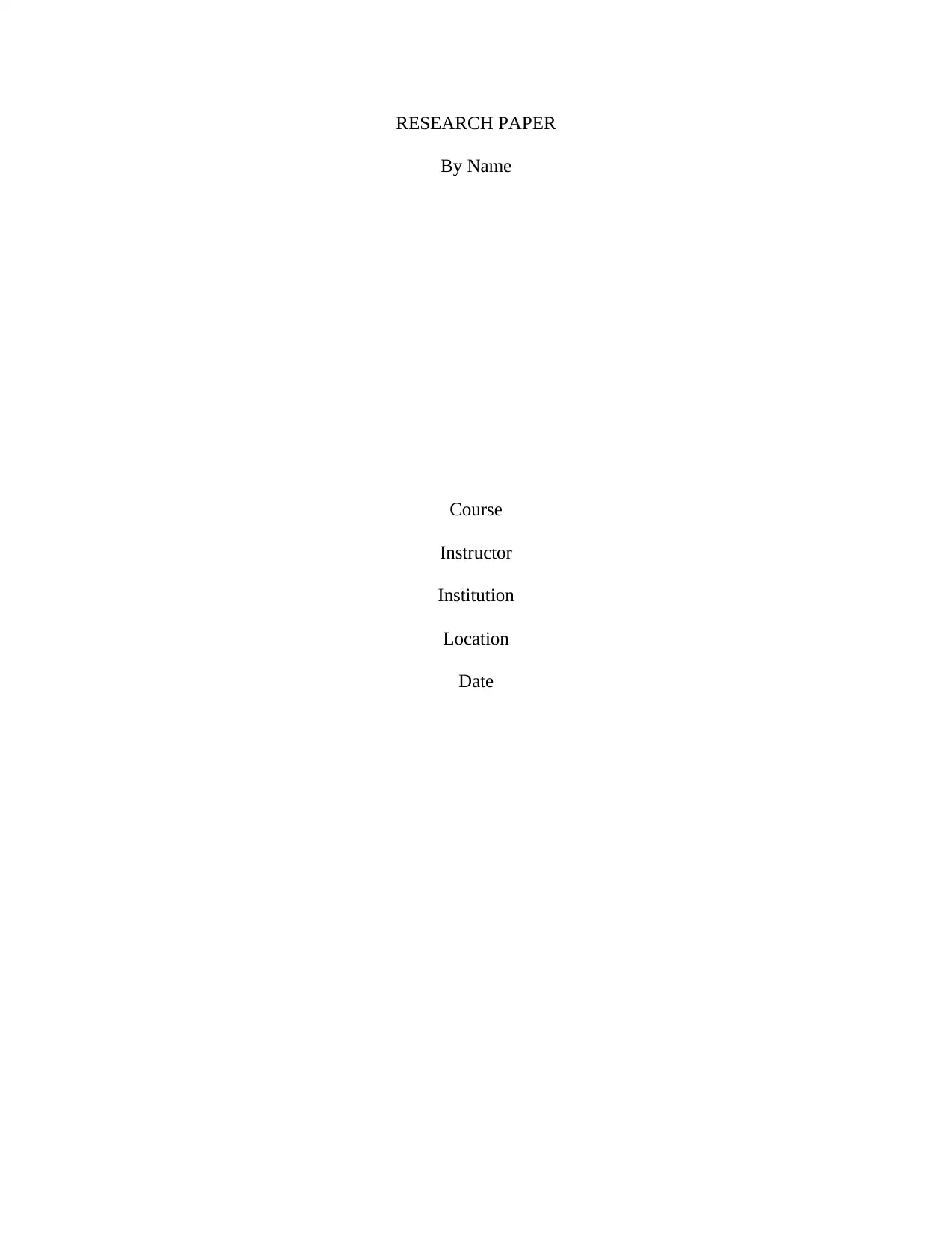
RESEARCH PAPER
By Name
Course
Instructor
Institution
Location
Date
By Name
Course
Instructor
Institution
Location
Date
Paraphrase This Document
Need a fresh take? Get an instant paraphrase of this document with our AI Paraphraser
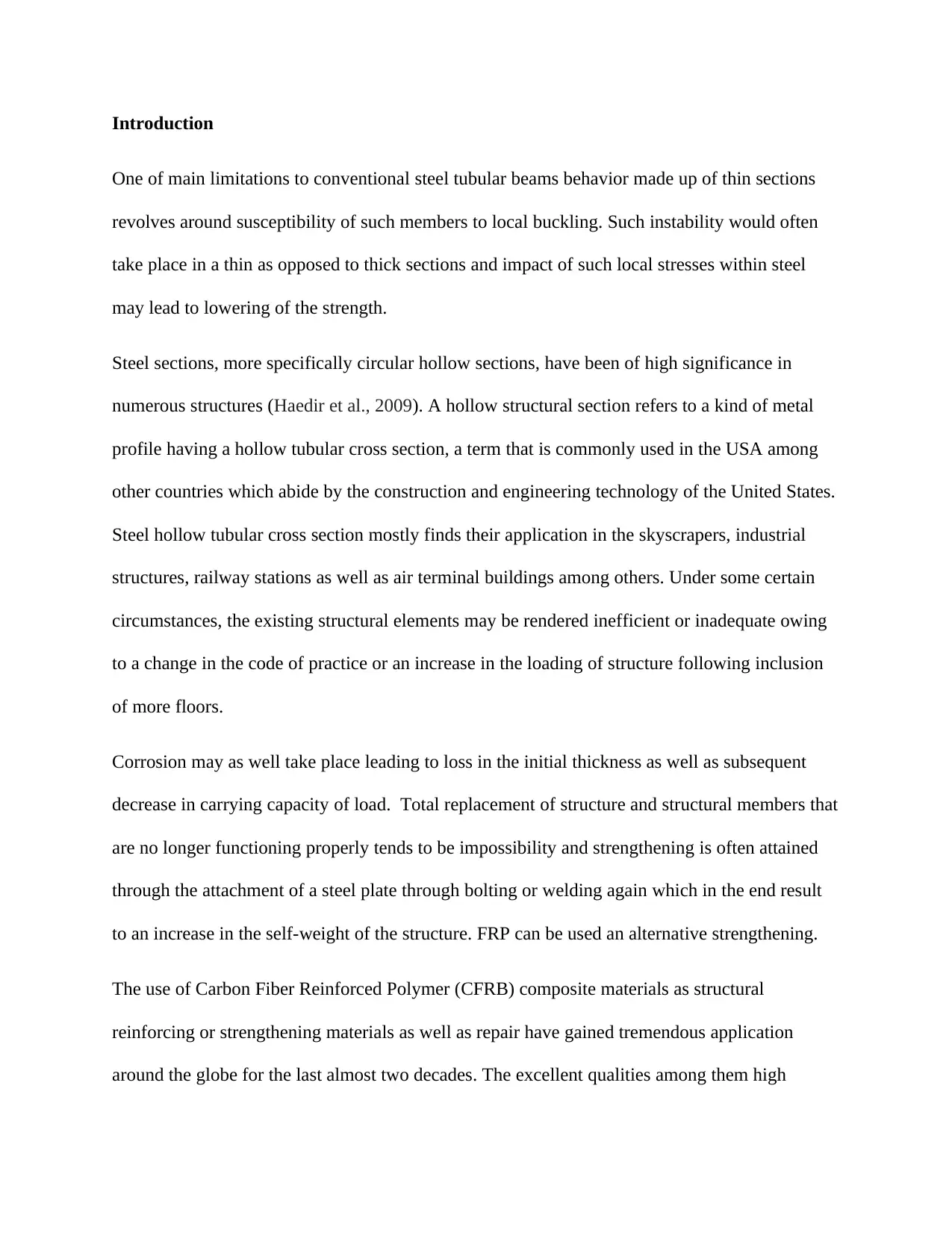
Introduction
One of main limitations to conventional steel tubular beams behavior made up of thin sections
revolves around susceptibility of such members to local buckling. Such instability would often
take place in a thin as opposed to thick sections and impact of such local stresses within steel
may lead to lowering of the strength.
Steel sections, more specifically circular hollow sections, have been of high significance in
numerous structures (Haedir et al., 2009). A hollow structural section refers to a kind of metal
profile having a hollow tubular cross section, a term that is commonly used in the USA among
other countries which abide by the construction and engineering technology of the United States.
Steel hollow tubular cross section mostly finds their application in the skyscrapers, industrial
structures, railway stations as well as air terminal buildings among others. Under some certain
circumstances, the existing structural elements may be rendered inefficient or inadequate owing
to a change in the code of practice or an increase in the loading of structure following inclusion
of more floors.
Corrosion may as well take place leading to loss in the initial thickness as well as subsequent
decrease in carrying capacity of load. Total replacement of structure and structural members that
are no longer functioning properly tends to be impossibility and strengthening is often attained
through the attachment of a steel plate through bolting or welding again which in the end result
to an increase in the self-weight of the structure. FRP can be used an alternative strengthening.
The use of Carbon Fiber Reinforced Polymer (CFRB) composite materials as structural
reinforcing or strengthening materials as well as repair have gained tremendous application
around the globe for the last almost two decades. The excellent qualities among them high
One of main limitations to conventional steel tubular beams behavior made up of thin sections
revolves around susceptibility of such members to local buckling. Such instability would often
take place in a thin as opposed to thick sections and impact of such local stresses within steel
may lead to lowering of the strength.
Steel sections, more specifically circular hollow sections, have been of high significance in
numerous structures (Haedir et al., 2009). A hollow structural section refers to a kind of metal
profile having a hollow tubular cross section, a term that is commonly used in the USA among
other countries which abide by the construction and engineering technology of the United States.
Steel hollow tubular cross section mostly finds their application in the skyscrapers, industrial
structures, railway stations as well as air terminal buildings among others. Under some certain
circumstances, the existing structural elements may be rendered inefficient or inadequate owing
to a change in the code of practice or an increase in the loading of structure following inclusion
of more floors.
Corrosion may as well take place leading to loss in the initial thickness as well as subsequent
decrease in carrying capacity of load. Total replacement of structure and structural members that
are no longer functioning properly tends to be impossibility and strengthening is often attained
through the attachment of a steel plate through bolting or welding again which in the end result
to an increase in the self-weight of the structure. FRP can be used an alternative strengthening.
The use of Carbon Fiber Reinforced Polymer (CFRB) composite materials as structural
reinforcing or strengthening materials as well as repair have gained tremendous application
around the globe for the last almost two decades. The excellent qualities among them high
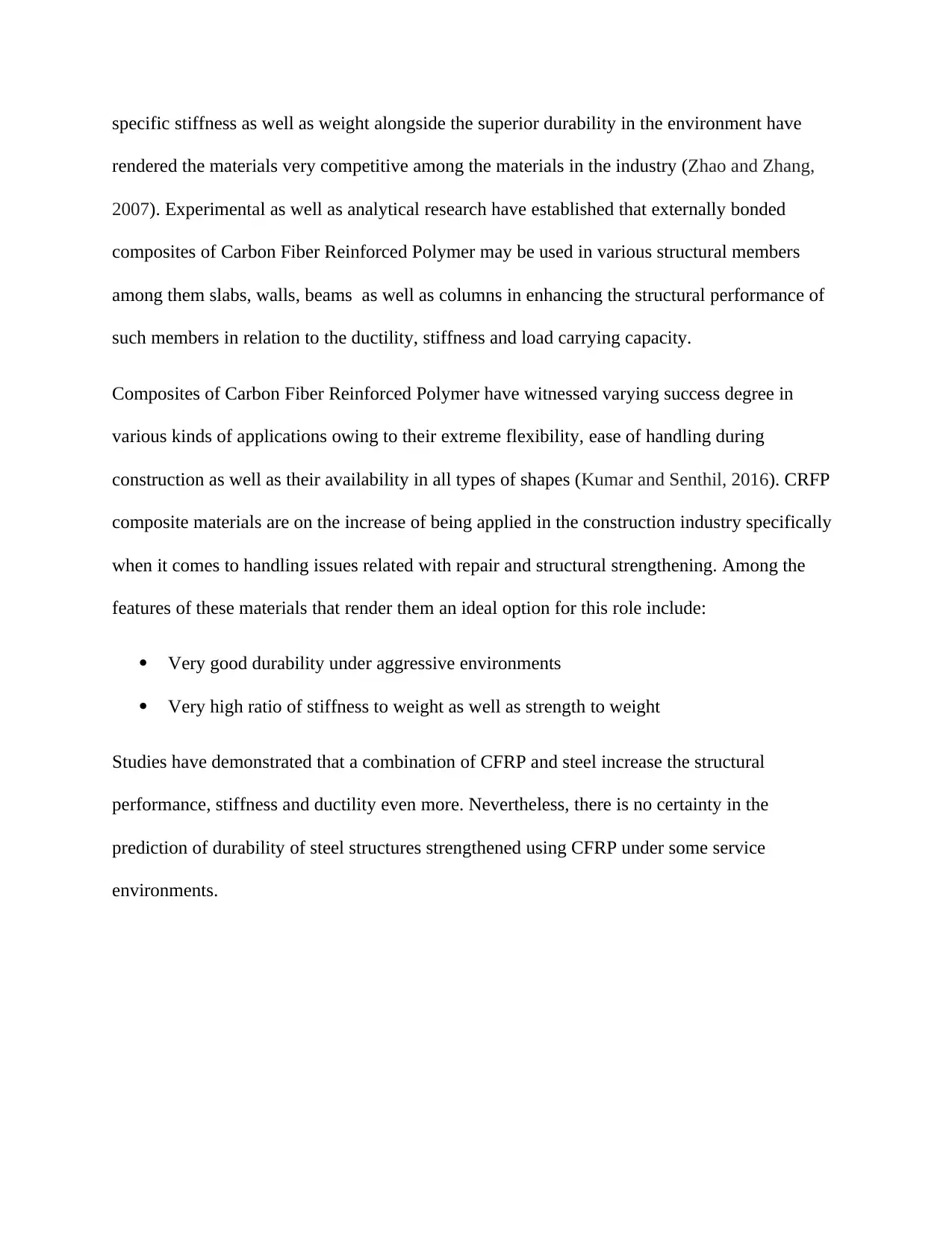
specific stiffness as well as weight alongside the superior durability in the environment have
rendered the materials very competitive among the materials in the industry (Zhao and Zhang,
2007). Experimental as well as analytical research have established that externally bonded
composites of Carbon Fiber Reinforced Polymer may be used in various structural members
among them slabs, walls, beams as well as columns in enhancing the structural performance of
such members in relation to the ductility, stiffness and load carrying capacity.
Composites of Carbon Fiber Reinforced Polymer have witnessed varying success degree in
various kinds of applications owing to their extreme flexibility, ease of handling during
construction as well as their availability in all types of shapes (Kumar and Senthil, 2016). CRFP
composite materials are on the increase of being applied in the construction industry specifically
when it comes to handling issues related with repair and structural strengthening. Among the
features of these materials that render them an ideal option for this role include:
Very good durability under aggressive environments
Very high ratio of stiffness to weight as well as strength to weight
Studies have demonstrated that a combination of CFRP and steel increase the structural
performance, stiffness and ductility even more. Nevertheless, there is no certainty in the
prediction of durability of steel structures strengthened using CFRP under some service
environments.
rendered the materials very competitive among the materials in the industry (Zhao and Zhang,
2007). Experimental as well as analytical research have established that externally bonded
composites of Carbon Fiber Reinforced Polymer may be used in various structural members
among them slabs, walls, beams as well as columns in enhancing the structural performance of
such members in relation to the ductility, stiffness and load carrying capacity.
Composites of Carbon Fiber Reinforced Polymer have witnessed varying success degree in
various kinds of applications owing to their extreme flexibility, ease of handling during
construction as well as their availability in all types of shapes (Kumar and Senthil, 2016). CRFP
composite materials are on the increase of being applied in the construction industry specifically
when it comes to handling issues related with repair and structural strengthening. Among the
features of these materials that render them an ideal option for this role include:
Very good durability under aggressive environments
Very high ratio of stiffness to weight as well as strength to weight
Studies have demonstrated that a combination of CFRP and steel increase the structural
performance, stiffness and ductility even more. Nevertheless, there is no certainty in the
prediction of durability of steel structures strengthened using CFRP under some service
environments.
⊘ This is a preview!⊘
Do you want full access?
Subscribe today to unlock all pages.

Trusted by 1+ million students worldwide
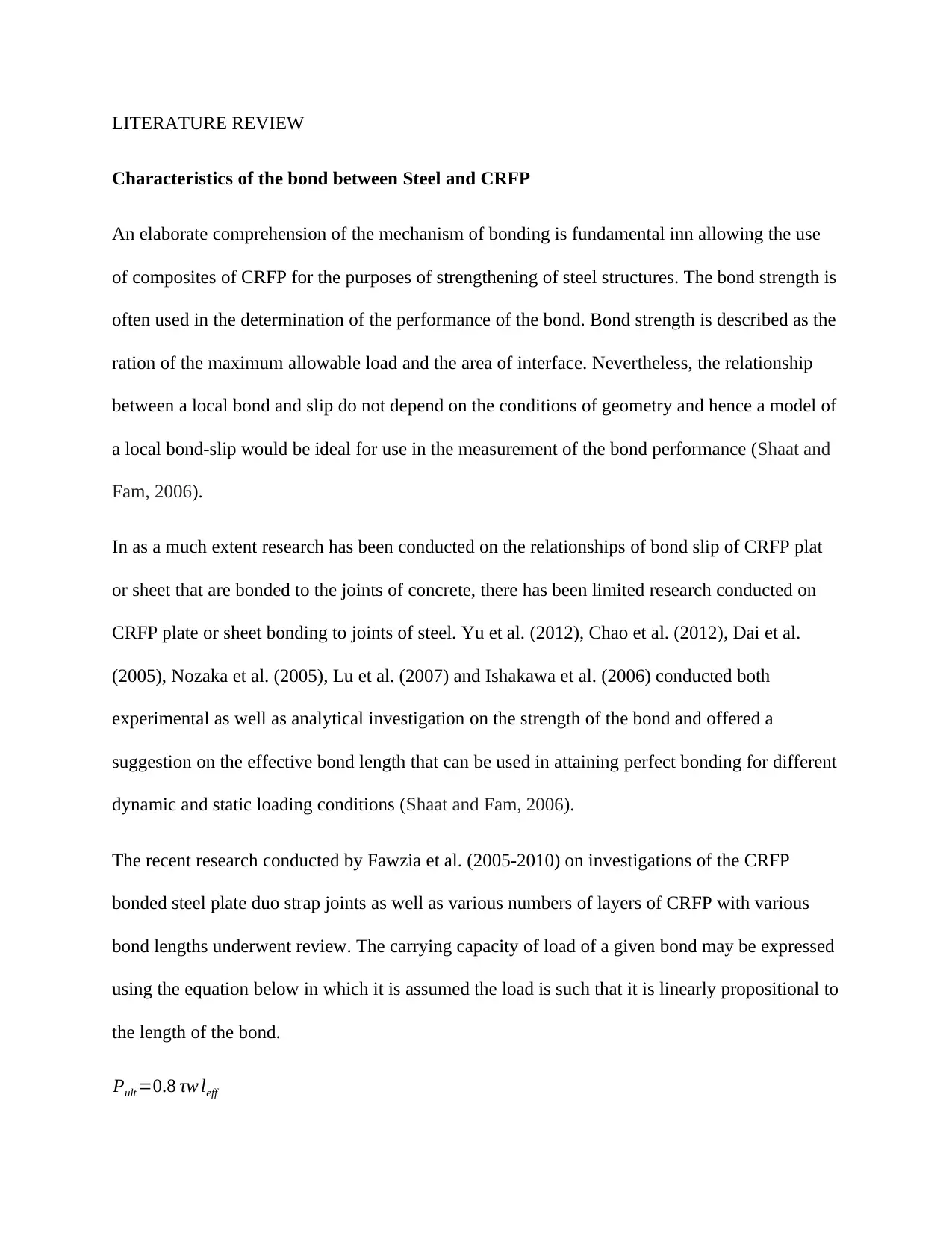
LITERATURE REVIEW
Characteristics of the bond between Steel and CRFP
An elaborate comprehension of the mechanism of bonding is fundamental inn allowing the use
of composites of CRFP for the purposes of strengthening of steel structures. The bond strength is
often used in the determination of the performance of the bond. Bond strength is described as the
ration of the maximum allowable load and the area of interface. Nevertheless, the relationship
between a local bond and slip do not depend on the conditions of geometry and hence a model of
a local bond-slip would be ideal for use in the measurement of the bond performance (Shaat and
Fam, 2006).
In as a much extent research has been conducted on the relationships of bond slip of CRFP plat
or sheet that are bonded to the joints of concrete, there has been limited research conducted on
CRFP plate or sheet bonding to joints of steel. Yu et al. (2012), Chao et al. (2012), Dai et al.
(2005), Nozaka et al. (2005), Lu et al. (2007) and Ishakawa et al. (2006) conducted both
experimental as well as analytical investigation on the strength of the bond and offered a
suggestion on the effective bond length that can be used in attaining perfect bonding for different
dynamic and static loading conditions (Shaat and Fam, 2006).
The recent research conducted by Fawzia et al. (2005-2010) on investigations of the CRFP
bonded steel plate duo strap joints as well as various numbers of layers of CRFP with various
bond lengths underwent review. The carrying capacity of load of a given bond may be expressed
using the equation below in which it is assumed the load is such that it is linearly propositional to
the length of the bond.
Pult=0.8 τw leff
Characteristics of the bond between Steel and CRFP
An elaborate comprehension of the mechanism of bonding is fundamental inn allowing the use
of composites of CRFP for the purposes of strengthening of steel structures. The bond strength is
often used in the determination of the performance of the bond. Bond strength is described as the
ration of the maximum allowable load and the area of interface. Nevertheless, the relationship
between a local bond and slip do not depend on the conditions of geometry and hence a model of
a local bond-slip would be ideal for use in the measurement of the bond performance (Shaat and
Fam, 2006).
In as a much extent research has been conducted on the relationships of bond slip of CRFP plat
or sheet that are bonded to the joints of concrete, there has been limited research conducted on
CRFP plate or sheet bonding to joints of steel. Yu et al. (2012), Chao et al. (2012), Dai et al.
(2005), Nozaka et al. (2005), Lu et al. (2007) and Ishakawa et al. (2006) conducted both
experimental as well as analytical investigation on the strength of the bond and offered a
suggestion on the effective bond length that can be used in attaining perfect bonding for different
dynamic and static loading conditions (Shaat and Fam, 2006).
The recent research conducted by Fawzia et al. (2005-2010) on investigations of the CRFP
bonded steel plate duo strap joints as well as various numbers of layers of CRFP with various
bond lengths underwent review. The carrying capacity of load of a given bond may be expressed
using the equation below in which it is assumed the load is such that it is linearly propositional to
the length of the bond.
Pult=0.8 τw leff
Paraphrase This Document
Need a fresh take? Get an instant paraphrase of this document with our AI Paraphraser
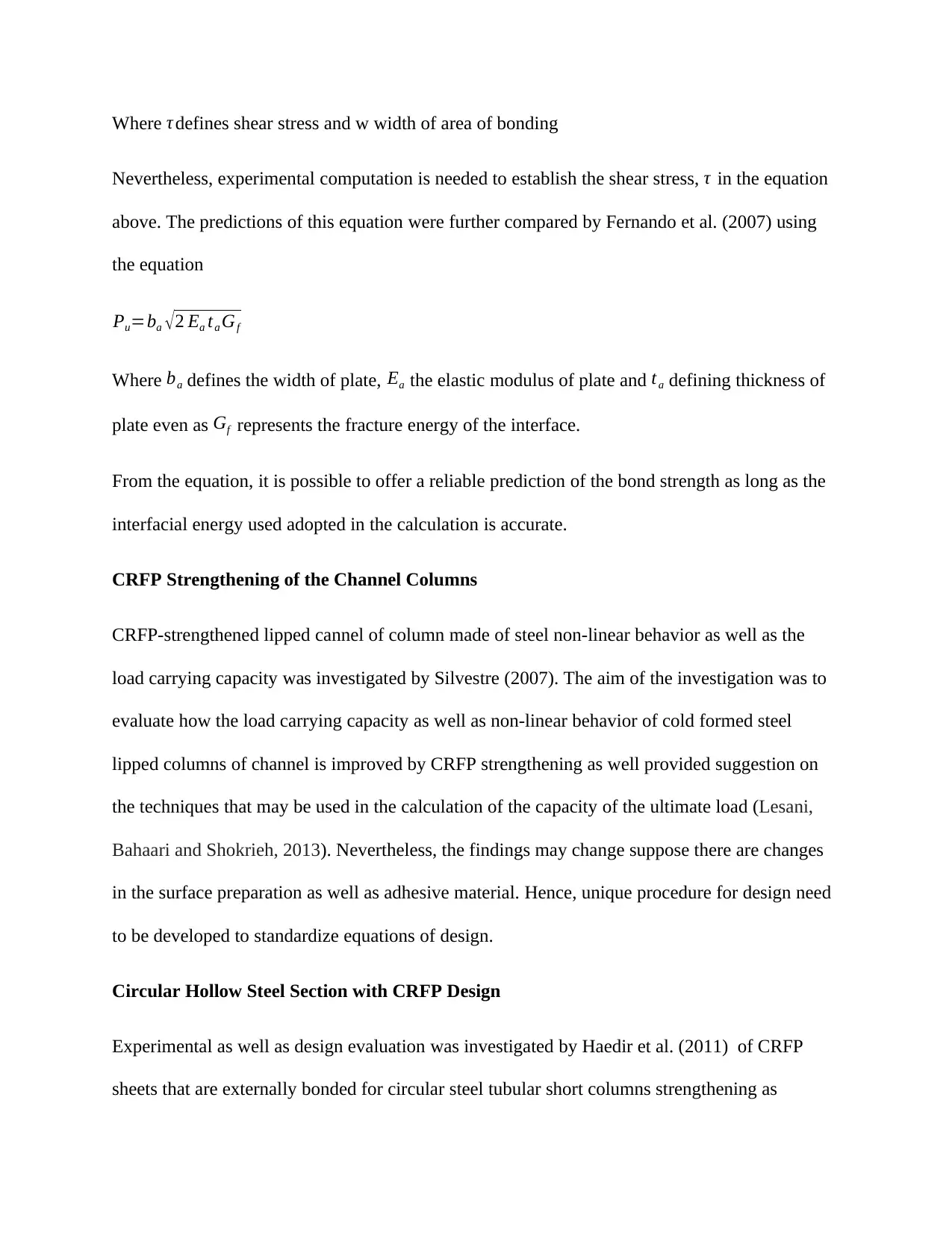
Where τ defines shear stress and w width of area of bonding
Nevertheless, experimental computation is needed to establish the shear stress, τ in the equation
above. The predictions of this equation were further compared by Fernando et al. (2007) using
the equation
Pu=ba √2 Ea ta Gf
Where ba defines the width of plate, Ea the elastic modulus of plate and ta defining thickness of
plate even as Gf represents the fracture energy of the interface.
From the equation, it is possible to offer a reliable prediction of the bond strength as long as the
interfacial energy used adopted in the calculation is accurate.
CRFP Strengthening of the Channel Columns
CRFP-strengthened lipped cannel of column made of steel non-linear behavior as well as the
load carrying capacity was investigated by Silvestre (2007). The aim of the investigation was to
evaluate how the load carrying capacity as well as non-linear behavior of cold formed steel
lipped columns of channel is improved by CRFP strengthening as well provided suggestion on
the techniques that may be used in the calculation of the capacity of the ultimate load (Lesani,
Bahaari and Shokrieh, 2013). Nevertheless, the findings may change suppose there are changes
in the surface preparation as well as adhesive material. Hence, unique procedure for design need
to be developed to standardize equations of design.
Circular Hollow Steel Section with CRFP Design
Experimental as well as design evaluation was investigated by Haedir et al. (2011) of CRFP
sheets that are externally bonded for circular steel tubular short columns strengthening as
Nevertheless, experimental computation is needed to establish the shear stress, τ in the equation
above. The predictions of this equation were further compared by Fernando et al. (2007) using
the equation
Pu=ba √2 Ea ta Gf
Where ba defines the width of plate, Ea the elastic modulus of plate and ta defining thickness of
plate even as Gf represents the fracture energy of the interface.
From the equation, it is possible to offer a reliable prediction of the bond strength as long as the
interfacial energy used adopted in the calculation is accurate.
CRFP Strengthening of the Channel Columns
CRFP-strengthened lipped cannel of column made of steel non-linear behavior as well as the
load carrying capacity was investigated by Silvestre (2007). The aim of the investigation was to
evaluate how the load carrying capacity as well as non-linear behavior of cold formed steel
lipped columns of channel is improved by CRFP strengthening as well provided suggestion on
the techniques that may be used in the calculation of the capacity of the ultimate load (Lesani,
Bahaari and Shokrieh, 2013). Nevertheless, the findings may change suppose there are changes
in the surface preparation as well as adhesive material. Hence, unique procedure for design need
to be developed to standardize equations of design.
Circular Hollow Steel Section with CRFP Design
Experimental as well as design evaluation was investigated by Haedir et al. (2011) of CRFP
sheets that are externally bonded for circular steel tubular short columns strengthening as
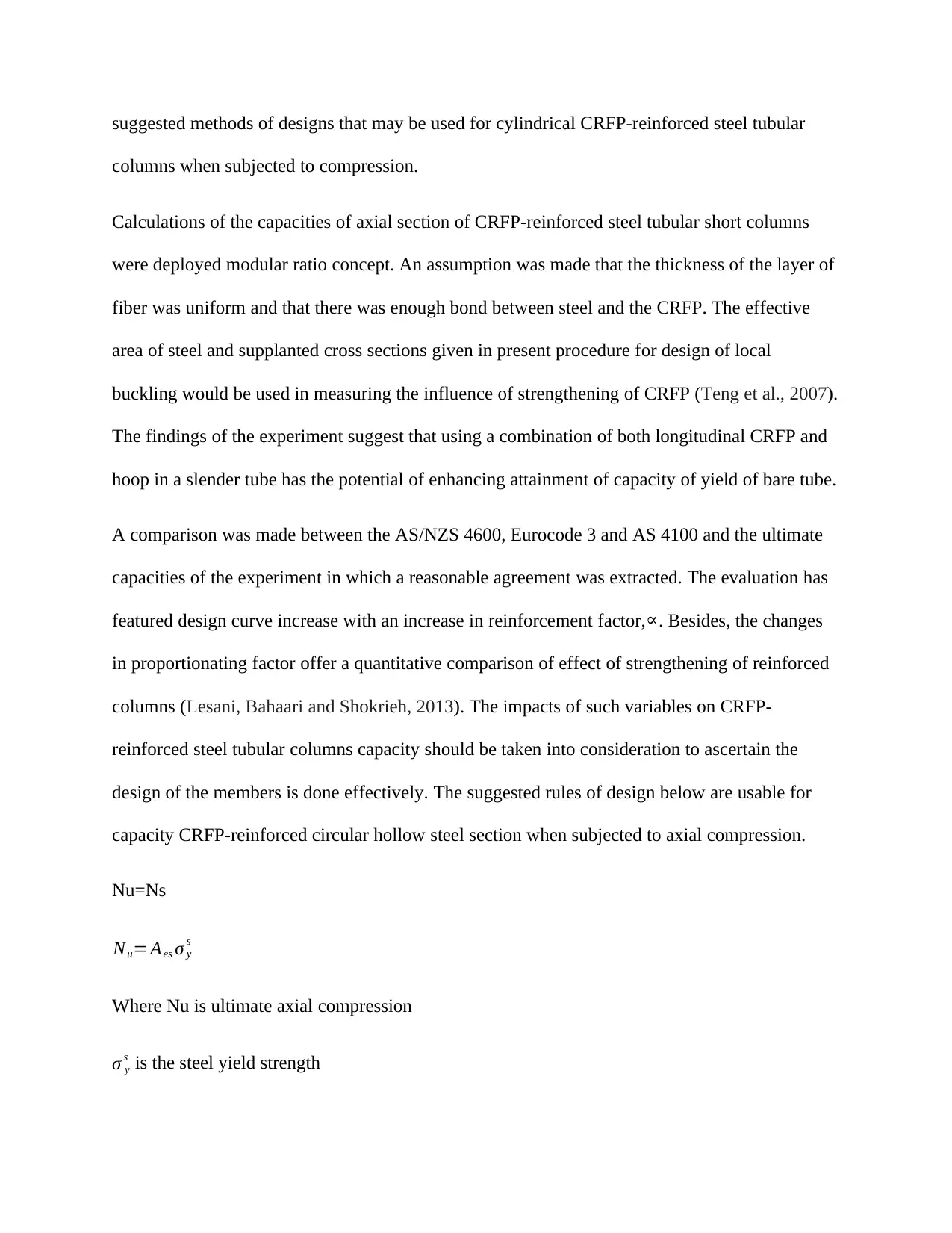
suggested methods of designs that may be used for cylindrical CRFP-reinforced steel tubular
columns when subjected to compression.
Calculations of the capacities of axial section of CRFP-reinforced steel tubular short columns
were deployed modular ratio concept. An assumption was made that the thickness of the layer of
fiber was uniform and that there was enough bond between steel and the CRFP. The effective
area of steel and supplanted cross sections given in present procedure for design of local
buckling would be used in measuring the influence of strengthening of CRFP (Teng et al., 2007).
The findings of the experiment suggest that using a combination of both longitudinal CRFP and
hoop in a slender tube has the potential of enhancing attainment of capacity of yield of bare tube.
A comparison was made between the AS/NZS 4600, Eurocode 3 and AS 4100 and the ultimate
capacities of the experiment in which a reasonable agreement was extracted. The evaluation has
featured design curve increase with an increase in reinforcement factor,∝. Besides, the changes
in proportionating factor offer a quantitative comparison of effect of strengthening of reinforced
columns (Lesani, Bahaari and Shokrieh, 2013). The impacts of such variables on CRFP-
reinforced steel tubular columns capacity should be taken into consideration to ascertain the
design of the members is done effectively. The suggested rules of design below are usable for
capacity CRFP-reinforced circular hollow steel section when subjected to axial compression.
Nu=Ns
Nu= Aes σ y
s
Where Nu is ultimate axial compression
σ y
s is the steel yield strength
columns when subjected to compression.
Calculations of the capacities of axial section of CRFP-reinforced steel tubular short columns
were deployed modular ratio concept. An assumption was made that the thickness of the layer of
fiber was uniform and that there was enough bond between steel and the CRFP. The effective
area of steel and supplanted cross sections given in present procedure for design of local
buckling would be used in measuring the influence of strengthening of CRFP (Teng et al., 2007).
The findings of the experiment suggest that using a combination of both longitudinal CRFP and
hoop in a slender tube has the potential of enhancing attainment of capacity of yield of bare tube.
A comparison was made between the AS/NZS 4600, Eurocode 3 and AS 4100 and the ultimate
capacities of the experiment in which a reasonable agreement was extracted. The evaluation has
featured design curve increase with an increase in reinforcement factor,∝. Besides, the changes
in proportionating factor offer a quantitative comparison of effect of strengthening of reinforced
columns (Lesani, Bahaari and Shokrieh, 2013). The impacts of such variables on CRFP-
reinforced steel tubular columns capacity should be taken into consideration to ascertain the
design of the members is done effectively. The suggested rules of design below are usable for
capacity CRFP-reinforced circular hollow steel section when subjected to axial compression.
Nu=Ns
Nu= Aes σ y
s
Where Nu is ultimate axial compression
σ y
s is the steel yield strength
⊘ This is a preview!⊘
Do you want full access?
Subscribe today to unlock all pages.

Trusted by 1+ million students worldwide
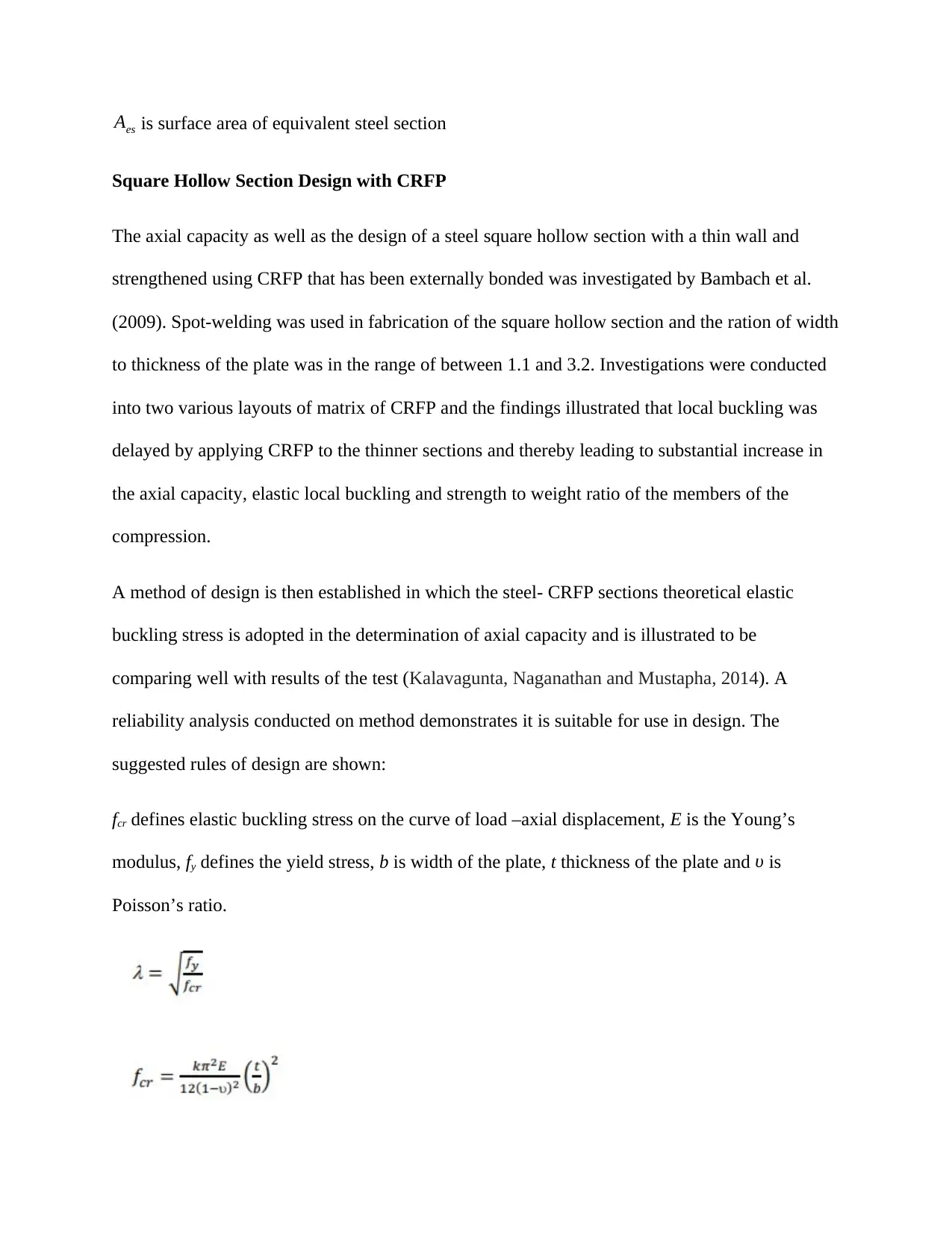
Aes is surface area of equivalent steel section
Square Hollow Section Design with CRFP
The axial capacity as well as the design of a steel square hollow section with a thin wall and
strengthened using CRFP that has been externally bonded was investigated by Bambach et al.
(2009). Spot-welding was used in fabrication of the square hollow section and the ration of width
to thickness of the plate was in the range of between 1.1 and 3.2. Investigations were conducted
into two various layouts of matrix of CRFP and the findings illustrated that local buckling was
delayed by applying CRFP to the thinner sections and thereby leading to substantial increase in
the axial capacity, elastic local buckling and strength to weight ratio of the members of the
compression.
A method of design is then established in which the steel- CRFP sections theoretical elastic
buckling stress is adopted in the determination of axial capacity and is illustrated to be
comparing well with results of the test (Kalavagunta, Naganathan and Mustapha, 2014). A
reliability analysis conducted on method demonstrates it is suitable for use in design. The
suggested rules of design are shown:
fcr defines elastic buckling stress on the curve of load –axial displacement, E is the Young’s
modulus, fy defines the yield stress, b is width of the plate, t thickness of the plate and υ is
Poisson’s ratio.
Square Hollow Section Design with CRFP
The axial capacity as well as the design of a steel square hollow section with a thin wall and
strengthened using CRFP that has been externally bonded was investigated by Bambach et al.
(2009). Spot-welding was used in fabrication of the square hollow section and the ration of width
to thickness of the plate was in the range of between 1.1 and 3.2. Investigations were conducted
into two various layouts of matrix of CRFP and the findings illustrated that local buckling was
delayed by applying CRFP to the thinner sections and thereby leading to substantial increase in
the axial capacity, elastic local buckling and strength to weight ratio of the members of the
compression.
A method of design is then established in which the steel- CRFP sections theoretical elastic
buckling stress is adopted in the determination of axial capacity and is illustrated to be
comparing well with results of the test (Kalavagunta, Naganathan and Mustapha, 2014). A
reliability analysis conducted on method demonstrates it is suitable for use in design. The
suggested rules of design are shown:
fcr defines elastic buckling stress on the curve of load –axial displacement, E is the Young’s
modulus, fy defines the yield stress, b is width of the plate, t thickness of the plate and υ is
Poisson’s ratio.
Paraphrase This Document
Need a fresh take? Get an instant paraphrase of this document with our AI Paraphraser
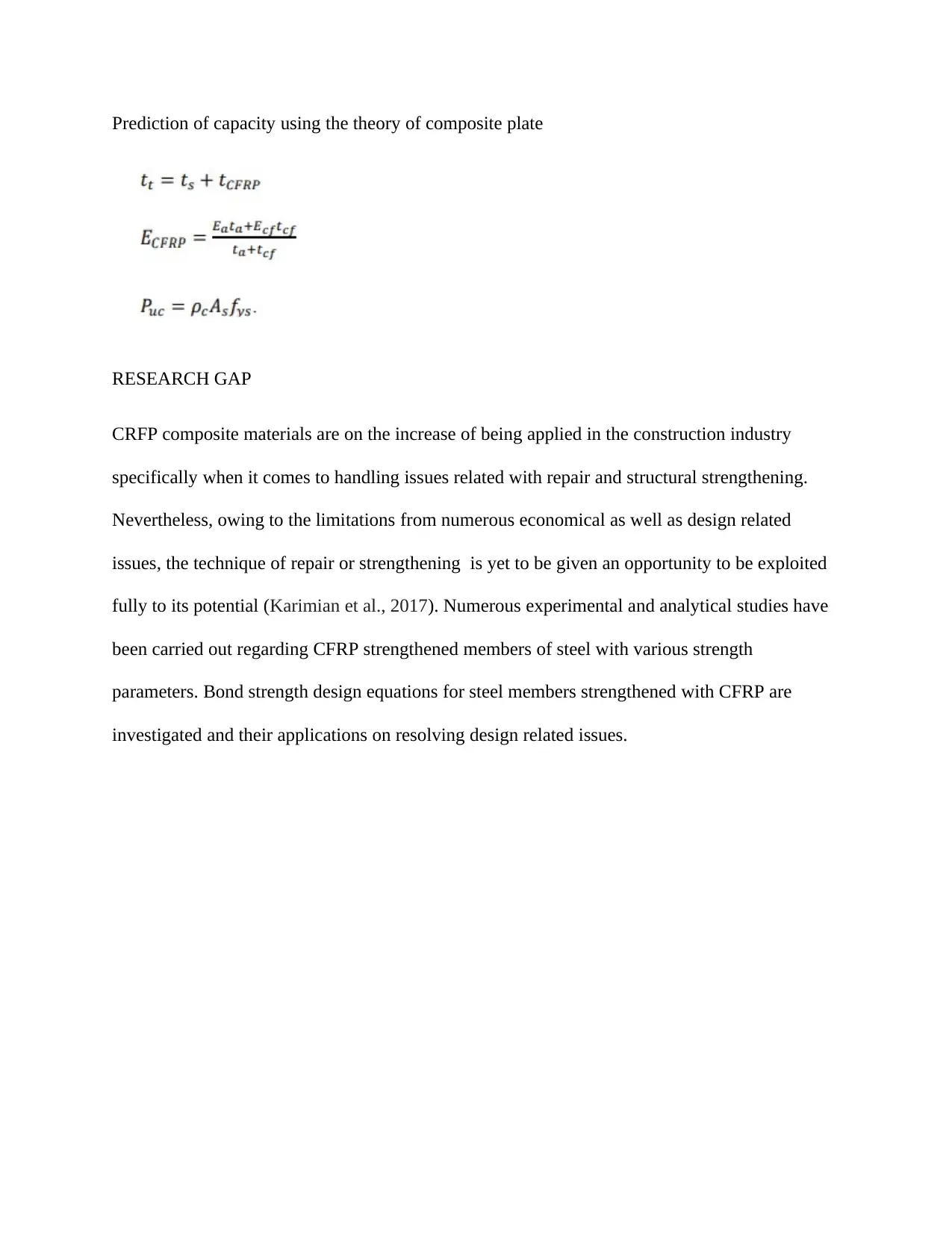
Prediction of capacity using the theory of composite plate
RESEARCH GAP
CRFP composite materials are on the increase of being applied in the construction industry
specifically when it comes to handling issues related with repair and structural strengthening.
Nevertheless, owing to the limitations from numerous economical as well as design related
issues, the technique of repair or strengthening is yet to be given an opportunity to be exploited
fully to its potential (Karimian et al., 2017). Numerous experimental and analytical studies have
been carried out regarding CFRP strengthened members of steel with various strength
parameters. Bond strength design equations for steel members strengthened with CFRP are
investigated and their applications on resolving design related issues.
RESEARCH GAP
CRFP composite materials are on the increase of being applied in the construction industry
specifically when it comes to handling issues related with repair and structural strengthening.
Nevertheless, owing to the limitations from numerous economical as well as design related
issues, the technique of repair or strengthening is yet to be given an opportunity to be exploited
fully to its potential (Karimian et al., 2017). Numerous experimental and analytical studies have
been carried out regarding CFRP strengthened members of steel with various strength
parameters. Bond strength design equations for steel members strengthened with CFRP are
investigated and their applications on resolving design related issues.
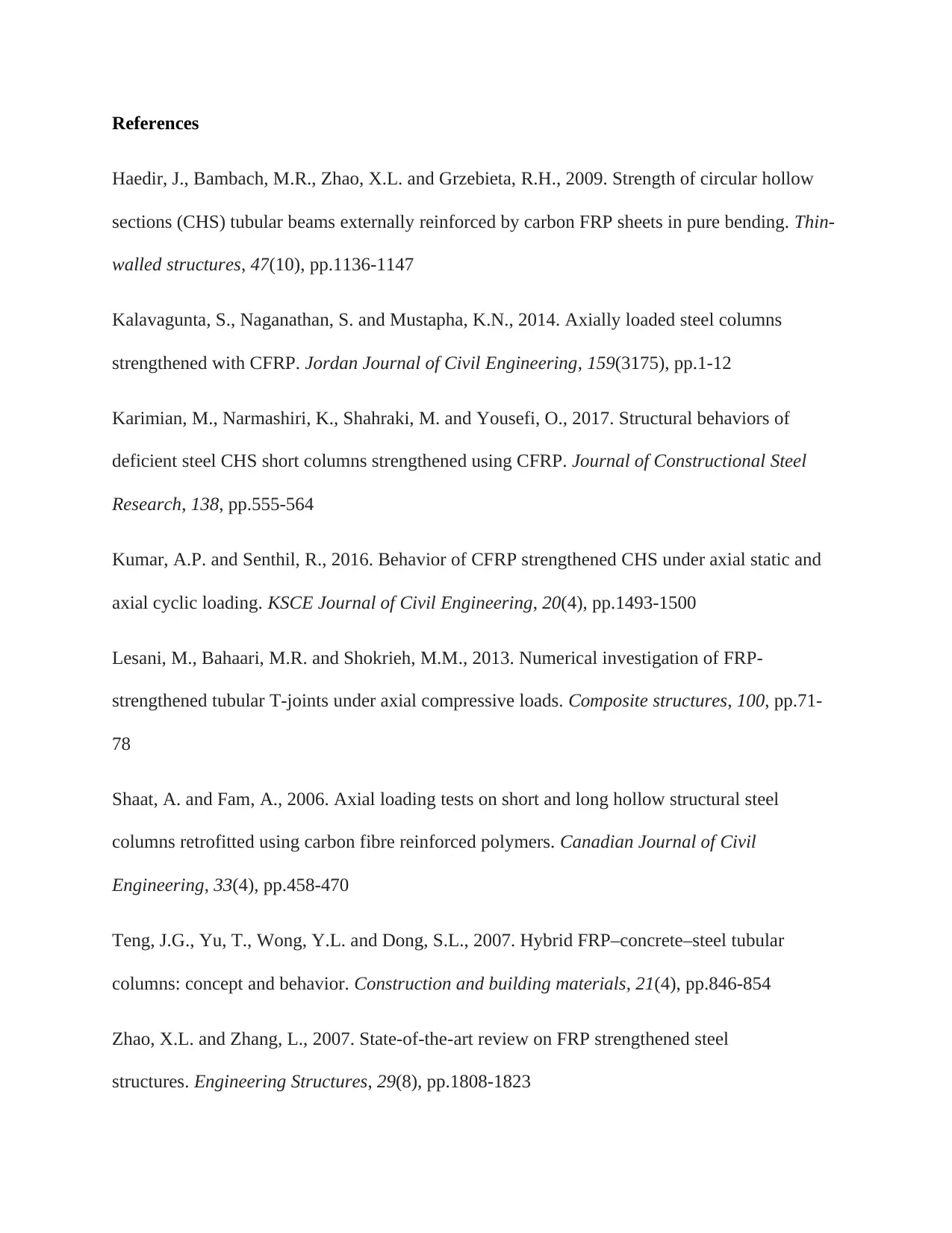
References
Haedir, J., Bambach, M.R., Zhao, X.L. and Grzebieta, R.H., 2009. Strength of circular hollow
sections (CHS) tubular beams externally reinforced by carbon FRP sheets in pure bending. Thin-
walled structures, 47(10), pp.1136-1147
Kalavagunta, S., Naganathan, S. and Mustapha, K.N., 2014. Axially loaded steel columns
strengthened with CFRP. Jordan Journal of Civil Engineering, 159(3175), pp.1-12
Karimian, M., Narmashiri, K., Shahraki, M. and Yousefi, O., 2017. Structural behaviors of
deficient steel CHS short columns strengthened using CFRP. Journal of Constructional Steel
Research, 138, pp.555-564
Kumar, A.P. and Senthil, R., 2016. Behavior of CFRP strengthened CHS under axial static and
axial cyclic loading. KSCE Journal of Civil Engineering, 20(4), pp.1493-1500
Lesani, M., Bahaari, M.R. and Shokrieh, M.M., 2013. Numerical investigation of FRP-
strengthened tubular T-joints under axial compressive loads. Composite structures, 100, pp.71-
78
Shaat, A. and Fam, A., 2006. Axial loading tests on short and long hollow structural steel
columns retrofitted using carbon fibre reinforced polymers. Canadian Journal of Civil
Engineering, 33(4), pp.458-470
Teng, J.G., Yu, T., Wong, Y.L. and Dong, S.L., 2007. Hybrid FRP–concrete–steel tubular
columns: concept and behavior. Construction and building materials, 21(4), pp.846-854
Zhao, X.L. and Zhang, L., 2007. State-of-the-art review on FRP strengthened steel
structures. Engineering Structures, 29(8), pp.1808-1823
Haedir, J., Bambach, M.R., Zhao, X.L. and Grzebieta, R.H., 2009. Strength of circular hollow
sections (CHS) tubular beams externally reinforced by carbon FRP sheets in pure bending. Thin-
walled structures, 47(10), pp.1136-1147
Kalavagunta, S., Naganathan, S. and Mustapha, K.N., 2014. Axially loaded steel columns
strengthened with CFRP. Jordan Journal of Civil Engineering, 159(3175), pp.1-12
Karimian, M., Narmashiri, K., Shahraki, M. and Yousefi, O., 2017. Structural behaviors of
deficient steel CHS short columns strengthened using CFRP. Journal of Constructional Steel
Research, 138, pp.555-564
Kumar, A.P. and Senthil, R., 2016. Behavior of CFRP strengthened CHS under axial static and
axial cyclic loading. KSCE Journal of Civil Engineering, 20(4), pp.1493-1500
Lesani, M., Bahaari, M.R. and Shokrieh, M.M., 2013. Numerical investigation of FRP-
strengthened tubular T-joints under axial compressive loads. Composite structures, 100, pp.71-
78
Shaat, A. and Fam, A., 2006. Axial loading tests on short and long hollow structural steel
columns retrofitted using carbon fibre reinforced polymers. Canadian Journal of Civil
Engineering, 33(4), pp.458-470
Teng, J.G., Yu, T., Wong, Y.L. and Dong, S.L., 2007. Hybrid FRP–concrete–steel tubular
columns: concept and behavior. Construction and building materials, 21(4), pp.846-854
Zhao, X.L. and Zhang, L., 2007. State-of-the-art review on FRP strengthened steel
structures. Engineering Structures, 29(8), pp.1808-1823
⊘ This is a preview!⊘
Do you want full access?
Subscribe today to unlock all pages.

Trusted by 1+ million students worldwide
1 out of 9
Related Documents
Your All-in-One AI-Powered Toolkit for Academic Success.
+13062052269
info@desklib.com
Available 24*7 on WhatsApp / Email
![[object Object]](/_next/static/media/star-bottom.7253800d.svg)
Unlock your academic potential
Copyright © 2020–2025 A2Z Services. All Rights Reserved. Developed and managed by ZUCOL.





